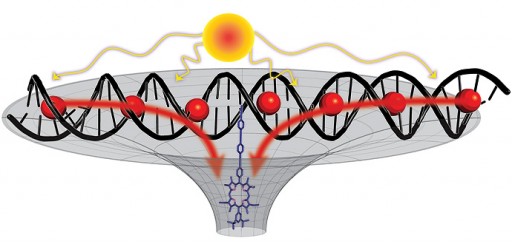Self-assembling DNA molecules act as scaffolding as a first step in creating artificial photosynthesis
June 26, 2013

An artificial light-collecting antenna system. A large number of light-absorbing dye molecules (red balls) are bound to a DNA molecule, which is then modified with a porphyrin unit (blue), creating of a self-assembling system that resembles light harvesting in natural photosynthesis. (Credit: Chalmers University of Technology)
A research team at Chalmers University of Technology The team has demonstrated that it is possible to use self-assembling DNA molecules as scaffolding as a first step to create artificial photosynthesis.
Proteins in plants and algae create a complex scaffolding (structure) that organizes chlorophyll molecules to collect light and use it to synthesize sugars and other energy-rich molecules in a reaction center. Previous attempts at replicating this structure have resulted in a fragile system. “It’s all over if a bond breaks,” says Dr. Jonas Hannestad, a physical chemist.
“If DNA is used instead to as scaffolds to organize the light-collecting molecules, the same precision is not achieved but a dynamic self-constructing system arises.” If any of the light-collecting molecules break, they will be replaced with another one a second later. It’s a self-repairing system as opposed to if molecules had been put there by researchers with synthetic organic chemistry.
This is because DNA strands have the ability to attach to each other in a predictable manner. As long as the correct assembly instructions are given, DNA strands in a test tube can bend around each other and basically form any structure.
In addition to DNA, they used light-absorbing dyes and a porphyrin acceptor molecule anchored to a lipid bilayer, conceptually mimicking natural plant light-harvesting systems.
“It’s like a puzzle where the pieces only fit together in one specific way,” says Bo Albinsson. “That is why it is possible to draw a fairly complex structure on paper and then know basically what it will look like. We subsequently use those traits to control how light collection will take place.”
However, while we can move energy to a reaction center, “we have not resolved how the reactions themselves are to take place there,” says Bo Albinsson, professor of physical chemistry and head of the research team. “This is actually the most difficult part of artificial photosynthesis.
Artificial photosynthesis is one of the hot trends in energy research. A large number of the worlds’ energy problems could be resolved if it were possible to recreate the ability plants have to transform solar energy into fuel, the researchers say.
The research was funded by the Swedish Research Council and the Swedish Energy Agency.